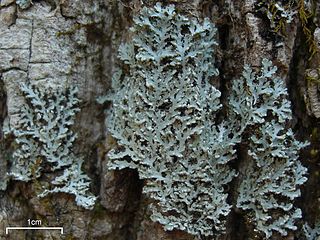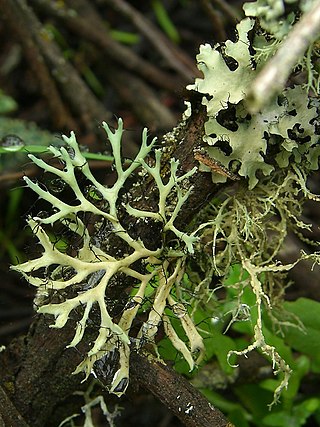
The Physciaceae are a family of mostly lichen-forming fungi belonging to the class Lecanoromycetes in the division Ascomycota. A 2016 estimate placed 19 genera and 601 species in the family.
Crustospathula is a genus of five species of crustose lichens in the family Malmideaceae. They are characterized by their stalked and sometimes branched cartilaginous soredia and Bacidia-like apothecia.

Anaptychia is a genus of lichen-forming fungi in the family Physciaceae. Anaptychia species are foliose (leafy) to fruticose (bushy) lichens. They have brown, thin-walled spores with a single septum, and a prosoplechtenchymatous upper cortex.

Heterodermia is a genus of lichenized fungi in the family Physciaceae. The genus has a widespread distribution, especially in tropical regions, and contains about 80 species.

Pyxine is a genus of foliose lichens in the family Caliciaceae. The genus has a widespread distribution in tropical regions.
Aderkomyces thailandicus is a species of corticolous (bark-dwelling), crustose lichen in the family Gomphillaceae. Found in the lower montane rainforests of Thailand, it was described as new to science in 2011.

Polyblastidium is a genus of foliose lichens in the family Physciaceae. It has 18 species. The genus was circumscribed by German lichenologist Klaus Kalb in 2015, with Polyblastidium japonicum assigned as the type species. Polyblastidium is similar in morphology to Heterodermia, but its lower surface is cobweb-like in structure (arachnoid), and its ascospores are mostly 1-septate with 1 to 3 sporoblastidia. It is this latter feature that is referenced in the genus name Polyblastidium. The genus contains several species that were formerly classified in the genus Anaptychia.

Leucodermia is a genus of lichen-forming fungi in the family Physciaceae.
Klaus Kalb is a German lichenologist and an authority on tropical lichens.
Pertusaria archeri is a rare species of corticolous (bark-dwelling), crustose lichen in the family Pertusariaceae. Found in Thailand, it was formally described as a new species in 2005 by Sureeporn Jariangprasert. The type specimen was collected by the author from Doi Khun Tan National Park at an altitude of 1,010 m (3,310 ft), where it was found in an evergreen forest growing on the bark of Styrax. The species epithet honours Australian lichenologist Alan W. Archer, an authority of Pertusaria taxonomy. The main distinguishing characteristics of Pertusaria archeri are its two-spored asci, and the presence of depside methyl esters as lichen products.
Pertusaria bokluensis is a rare species of corticolous (bark-dwelling), crustose lichen in the family Pertusariaceae. Found in Thailand, it was formally described as a new species in 2005 by Sureeporn Jariangprasert. The type specimen was collected from the Bo Kluea Nhuea community at an altitude of 1,000 m (3,300 ft), where it was found growing on the bark of Dalbergia. It is only known from the type specimen. The species epithet combines the name of the type locality with the Latin adjective -ensis, meaning "place of origin". The main distinguishing characteristics of Pertusaria bokluensis are the eight-spored asci, and the presence of the lichen products 4,5-dichlorolichexanthone and 2,2'-di-O-methylstenosporic acid.
Pertusaria elixii is a rare species of corticolous (bark-dwelling), crustose lichen in the family Pertusariaceae. Found in Thailand, it was formally described as a new species in 2005 by Sureeporn Jariangprasert. The type specimen was collected by the author from Doi Inthanon National Park at an altitude of 1,900 m (6,200 ft), where it was found growing on Betula alnoides. The species epithet honours Australian lichenologist John Elix, who assisted the author in chemical analysis of lichen specimens. Pertusaria elixii is distinguished from related species by the number of ascospores in its ascus (four), and the presence of 2'-O-methyl-substituted homologues of perlatolic acid.
Pertusaria hypostictica is a species of corticolous (bark-dwelling), crustose lichen in the family Pertusariaceae. Found in Thailand, it was formally described as a new species in 2005 by Sureeporn Jariangprasert. The type specimen was collected from Khao Yai National Park at an altitude of 1,233 m (4,045 ft), where it was found growing on the bark of a Fagaceae plant. It has also been found in the peninsular region in the southern part of Thailand. The species epithet refers to the presence of hypostictic acid as a minor lichen product. It also contains stictic acid as a major substance, minor amounts of cryptostictic acid, peristictic acid, substictic acid, and trace amounts of constictic acid.
Pertusaria inthanonensis is a species of crustose lichen in the family Pertusariaceae. Found in northern and northeastern Thailand, it was formally described as a new species in 2005 by Sureeporn Jariangprasert. The type specimen was collected by the author from the Doi Inthanon National Park at an altitude of 1,900 m (6,200 ft), where it was found growing on the bark of a birch tree. The species epithet combines the name of the type locality with the Latin suffix ensis. The main distinguishing characteristics of the lichen are its asci that contain either two or four smooth ascospores, and the presence of confluentic acid, stictic acid, and lichexanthone. The latter substance causes the thallus to fluoresce a bright yellow colours when lit with a long-wavelength UV light.
Pertusaria kansriae is a rare species of corticolous (bark-dwelling), crustose lichen in the family Pertusariaceae. Found in Thailand, it was formally described as a new species in 2005 by Sureeporn Jariangprasert. The type specimen was collected by the author from the Doi Inthanon National Park at an altitude of 980 m (3,220 ft), where it was found growing on a tree trunk in a mixed forest; the species is known only from this specimen. The species epithet kansriae honours Thai lichenologist Kansri Boonpragob, who inspired the author to study lichens. Distinguishing characteristics of the lichen are the number of ascospores in the ascus (four), and the presence of the lichen products 4,5-dichlorolichexanthone and 2'-O-methylstenosporic acid.
Pertusaria krabiensis is a rare species of corticolous (bark-dwelling), crustose lichen in the family Pertusariaceae. Found in peninsular Thailand, it was formally described as a new species in 2005 by Sureeporn Jariangprasert. The type specimen was collected from near the Wat Thamp Suea Temple in Krabi; the species is known only from the type. The species epithet combines the name of the type locality with the Latin suffix -ensis. The main distinguishing characteristics of Pertusaria krabiensis are its uniseriate ascospores, and the presence of homologues of the lichen product 2-O-methylperlatolic acid.
Pertusaria siamensis is a species of corticolous (bark-dwelling), crustose lichen in the family Pertusariaceae. Found in Thailand, it was formally described as a new species in 2005 by Sureeporn Jariangprasert. The type specimen was collected by the author from the Chae Son National Park at an altitude of 720 m (2,360 ft), where it was found in a dry dipterocarp forest growing on Shorea obtusa. The lichen is common in several Thai national parks in various parts of the country, occurring at elevations ranging from 200 to 1,600 m. In addition to Shorea, Pertusaria siamensis has also been recorded growing on Dipterocarpus, Ficus, and Vatica. The species epithet combines the old name for Thailand ("Siam") with the Latin suffix -ensis.
Pertusaria uttaraditensis is a rare species of corticolous (bark-dwelling), crustose lichen in the family Pertusariaceae. Found in Thailand, it was formally described as a new species in 2005 by Sureeporn Jariangprasert. The type specimen was collected from Phu Soi Dao National Park at an elevation of 1,020 m (3,350 ft), where it was found growing on a foetid vine near a dry dipterocarp forest. The species epithet combines the province of the type locality with the Latin suffix -ensis.
Gassicurtia omiae is a species of corticolous (bark-dwelling), crustose lichen in the family Caliciaceae. Found in Thailand, it was formally described as a new species in 2009 by lichenologist Klaus Kalb. The species epithet omiae honours Mrs. W. Saipunkaew ("Om"), who assisted the author as a guide and discovered the species in the field. Gassicurtia omiae is the first species of Gassicurtia with a sorediate thallus and the first that produces the lichen product 6-O-methylarthothelin.
Pyxine profallax is a species of corticolous (bark-dwelling), foliose lichen in the family Caliciaceae. It is found in Australia, Papua New Guinea, and Thailand.






